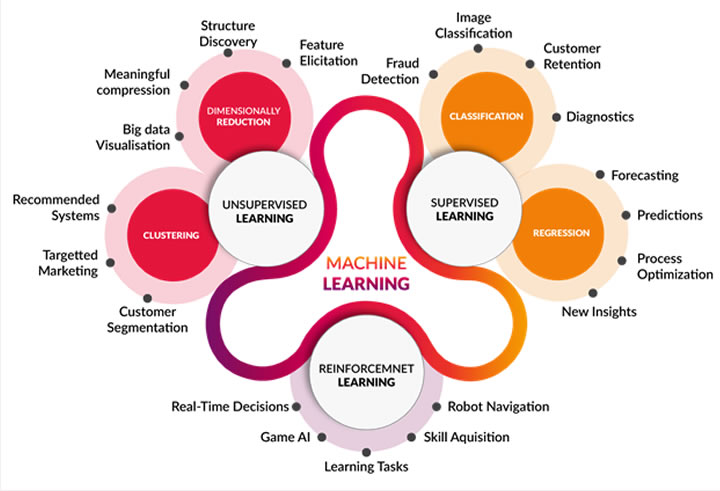Have you ever thought about intelligent machines that rule the world? Actually, they do this right now thanks to machine learning or ML.
Nowadays, we see active development of machine learning in healthcare, FinTech, retail, logistics, government, gaming, and so forth. Virtual assistants, machine-generated art, content recommendations, tools that analyze disease symptoms, self-driving cars – there are dozens of successful cases. But we want to cover essentials here. Check out three questions and answers, and you’ll learn all key facts about ML for beginners. Let’s go!
#1 – What Is Machine Learning?
In general, machine learning is the process of teaching computers to find patterns in data sets. These packages are massive and their types are different: texts, images, histories, etc. After a lot of iterations and numerous data sets consumed, machines can find the spotted patterns in new information that they see for the first time.
Here are a few examples to make it clearer:
- Alexa and Siri learn how to talk to you using numerous records of conversations.
- Gmail puts some emails into the Spam folder after analyzing the content.
- Netflix recommends your new series based on the things you watched before.
- Self-driving cars identify people and other vehicles using their machine vision.
- YouTube creates captions thanks to automated speech recognition.
The key difference between these machines and traditional software is that they learned how to complete tasks. While general apps rely on code written by a human, smart systems aren’t instructed. They consume data and get these skills in the process of learning.
Sure, this definition is pretty straightforward but it’s universal. There are more ML-based tech things like neural networks, deep learning, supervised and unsupervised algorithms, reinforcement learning but they deserve another guide.

Types of ML
#2 – Why Is Machine Learning Essential?
Mostly, ML relies on Big Data. It’s not a secret that we generate more and more data, the industry is actively growing, and new demands emerge. Machine learning addresses these needs. Thanks to more powerful and affordable processing/storage systems, ML experts can upgrade their tools regularly. They analyze more complex and innovative data, deliver more accurate results, and enable new values on virtually all markets.
Here’s a shorter answer: machine learning is vital now because it lets computers handle human tasks faster, more accurate, and on larger scales.
#3 – Where Is Machine Learning Used?
And here’s the third basic thing to cover. We mentioned how ML algorithms assist you in your daily life (even if you don’t realize this fact). Now, let’s briefly check out how machine learning works in different industries. The most popular ones are as follows:
- ML can help companies to find new sources and traditional resources like oil or gas. It also improves energy distribution through smart grids.
- Banks use ML to identify investment opportunities, spot market trends, study risks associated with clients, prevent fraud.
- On the scale of whole countries, ML helps in data mining, making it simpler to gather information about citizens and protect it.
- Wearables trackers and intelligent sensing tools based on ML help to get patient data in real-time, analyze symptoms, deliver timely treatment.
- ML makes logistics routes more efficient, predicts risks. As well, it can help with customer demand, optimize public transport.
Remember that ML drives innovations: autonomous vehicles, recognition systems, AI. It can be used in any industry or market sector. The question is that the algorithms are still relatively expensive so not all businesses need them.
Learn More About ML
If you feel that machine learning is your area of interest, don’t limit yourself! Start researching this topic. Today, a lot of online courses are free. Definitely, some of them cover ML and related domains. For instance, check the Stanford-backed course at Coursera. It has a 4.9/5.0 rating with more than 130,000 participants!
As well, explore topical YouTube channels. Again, Stanford has several video lectures dedicated to machine learning. CrashCourse explores ML & AI. OxfordSparks tells about machine learning in just two minutes. You got the idea – just type keywords in your YouTube search, and enjoy the top-rated videos.
Finally, feel free to study more significant resources. Books, academic papers, comprehensive guides – there are dozens of examples for readers with different backgrounds. And if you’re really into ML, consider studying it fundamentally. Nearly all tech-oriented universities and schooled have programs in this field.
That’s it. Learn about machine learning, educate yourself, and change the world!
